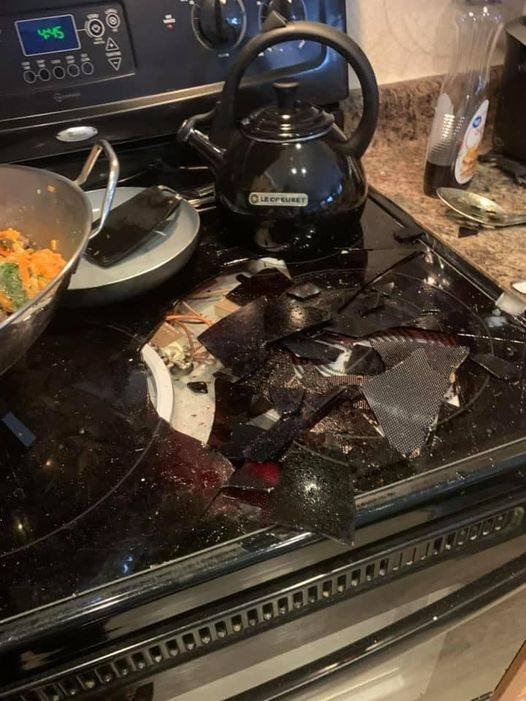Glass stovetops are a popular choice for modern kitchens, prized for their sleek design and ease of cleaning. However, these appliances require special care to maintain their appearance and functionality. Improper use can lead to scratches, cracks, or even safety hazards. To keep your glass stovetop in top condition, avoid these ten common mistakes that could cause serious damage.

1. Using Rough or Abrasive Cleaners
One of the fastest ways to ruin a glass stovetop is by using rough or abrasive cleaning materials. Steel wool, scrubbing pads, or harsh chemical cleaners can leave scratches that dull the surface and compromise its integrity over time. Instead, always use a gentle cleaner specifically designed for glass stovetops. A microfiber cloth or soft sponge works well for wiping down the surface without causing damage.
2. Placing Heavy Pots and Pans
While glass stovetops are durable, they are not designed to handle the weight of heavy cookware. Cast iron pots, oversized pans, or heavy stockpots can crack or shatter the glass, especially if dropped. Opt for lightweight cookware whenever possible, and avoid placing anything excessively heavy on your stovetop to prevent long-term damage.
3. Sliding Pots and Pans
Sliding pots and pans across the surface of a glass stovetop can lead to unsightly scratches. Over time, these marks can accumulate, making your stovetop look worn and reducing its efficiency. Always lift your cookware when moving it from one burner to another to protect the glass surface.
4.Leaving spills and stains on your stovetop might seem harmless, but over time, they can become baked onto the surface, making them harder to remove. This buildup can also lead to discoloration or damage to the glass. To keep your stovetop looking pristine, clean spills promptly. A damp cloth or stovetop-safe cleaner is often all you need to tackle minor messes before they become a problem.
5. Cooking with Dirty Cookware
Using pots and pans with residue, grease, or burnt material on the bottom can harm your glass stovetop. These particles can transfer to the glass and cause scratches or stains. Before placing cookware on the stovetop, ensure the bottoms are clean and free of debris. This simple habit will help keep your stovetop in excellent condition for years to come.
6. Placing Hot Lids Face Down
Hot lids, especially glass ones, can create sudden temperature changes when placed face down on a cool stovetop. This can cause the glass to crack or shatter. Instead, place hot lids on a heat-resistant surface, such as a trivet or pot holder, to avoid damaging your stovetop.
7. Ignoring Cracks or Chips
Small cracks or chips on a glass stovetop may seem like a minor issue, but they can worsen over time. Heat and pressure can expand these flaws, potentially leading to the entire stovetop shattering during use. If you notice any damage, it’s crucial to address it immediately. Consult a professional repair service to assess the problem and prevent further risks.
8. Heating an Empty Pot or Pan
Placing an empty pot or pan on a hot burner can cause it to overheat, which can damage both the cookware and the stovetop. Overheated cookware can leave permanent marks or even cause the glass to crack due to extreme temperature changes. Always ensure there is food or liquid in the cookware before heating.
9. Using the Wrong Cookware
Not all cookware is suitable for use on a glass stovetop. Cookware with warped or uneven bottoms can cause hot spots, leading to inefficient cooking and potential damage to the surface. Similarly, materials like cast iron and stoneware are heavy and prone to scratching or cracking the glass. Stick to cookware designed for smooth-top stoves, such as stainless steel or anodized aluminum, for the best results.
10. Not Following the Manufacturer’s Instructions
Every glass stovetop comes with specific care and usage instructions provided by the manufacturer. Ignoring these guidelines can lead to avoidable damage or even void your warranty. Take the time to read the manual and follow the recommended practices for cleaning, maintenance, and cookware selection. Doing so will help extend the life of your stovetop and ensure safe use.
Final Thoughts
Glass stovetops are a sleek and functional addition to any kitchen, but they require proper care and attention to remain in good condition. By avoiding these ten dangerous habits, you can prevent scratches, cracks, and other damage that could compromise your stovetop’s appearance and functionality.
Treat your glass stovetop with care, clean it regularly using appropriate products, and always handle cookware mindfully. With these precautions, you’ll enjoy a beautiful and efficient cooking surface for years to come.





